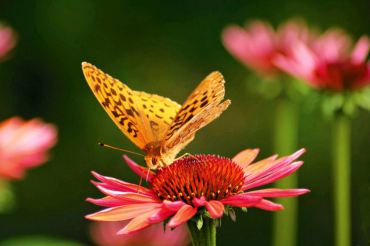 WestSound Magazine readers have asked us to publish information about attracting hummingbirds and butterflies to their gardens. The following information has been gathered from past WSH&G articles and consolidated into the following pages. Please enjoy and have fun attracting these flying jewels to your own gardens.
WestSound Magazine readers have asked us to publish information about attracting hummingbirds and butterflies to their gardens. The following information has been gathered from past WSH&G articles and consolidated into the following pages. Please enjoy and have fun attracting these flying jewels to your own gardens.
Keep in mind that the Anna’s Hummingbirds actually stay here all year long so you’ll want to supplement their natural food sources (plants and flowers) with hummingbird feeders in the winter time.
Also remember that butterflies are most active in the summer and early fall so save this “springy” piece for info on attracting butterflies during the warmer, balmier months.
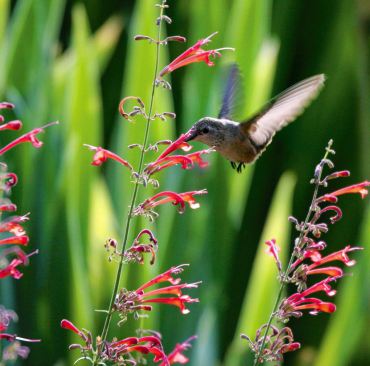
Hummingbird Attractors
This is the time of year when you really start noticing hummingbirds in your garden. Keep your eyes peeled for Rufous Hummingbirds and their cousins, the Anna’s Hummingbird. Rufous males are orange-brown, with scarlet tails and flanks, and a green crown. The female has a green back and rufous (coppery red) sides and red spots on her throat. The Anna’s male has a rose head and throat but his body is green and he’s larger than the Rufous. Both Anna’s and Rufous have bits of white on their chest and neck areas.
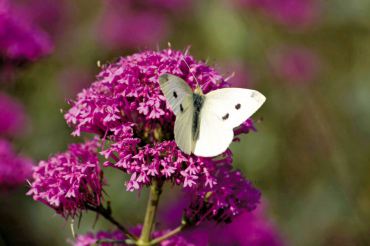
In addition to plants and hummingbird feeders, you may also see the hummingbirds landing on suet feeders. They’ll dive bomb the other birds if given the chance. The hummingbirds are tiny but mighty. They’re territorial and they make indescribable yet delightful sounds as they zip and flitter around gardens looking for tasty plants to sip from.
Hummingbirds nest in salmonberries and other plants both native and non-native. Look closely when walking through your own garden or neighborhoods. Keep your eyes peeled for the hummers’ minute nest. It will be lined with what looks like gossamer. The materials are really dandelion fuzz, cobwebs and other bits of filmy material.
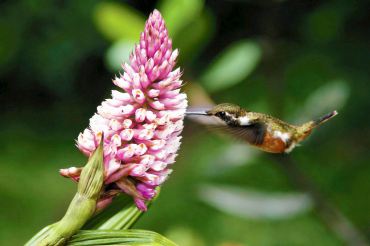 Eggs are the size of a small child’s fingernails. When these teensy eggs hatch, the babies are born without feathers except for a frosting of downiness and are all eyes and beaks.
Eggs are the size of a small child’s fingernails. When these teensy eggs hatch, the babies are born without feathers except for a frosting of downiness and are all eyes and beaks.
Hummingbirds are amazingly fast, with wing beats of 53 beats per second in normal flight and heart beats at the rate of 1,260 beats per minute. Bright colors signal it’s time to pause and sip some nectar. Look for tube-shaped red, pink and orange plants to attract hummers. Consult with your favorite nursery staff for a list of their favorite hummingbird attracting plants, or select from this short list:
- Anise hyssop
- Sages
- Salvias
- Monarda
- Epimidium
- Canna
- Phygelius capensis (cape fuchsia)
- Honeysuckle
- Lobelia
- Heuchera
- Fuchsia — both annual and hardy varieties
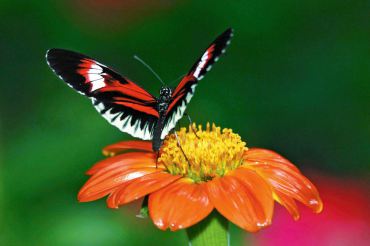
Butterflies Are Flying Jewels
Spring and summer are the perfect times to haunt the local nurseries and garden centers in search of plants to attract butterflies. Butterflies are nature’s flying jewels. But they’re also tremendous pollinators. Their long tongues are perfect for pollinating tube-shaped flowers.
Their eggs are laid on the undersides of leaves. Kids love to look for the clusters of tiny eggs on the leaves of trees and perennials. Caterpillars are the eating machines of this insect family. If you’d like to attract butterflies to your garden, you’ll also need to tolerate the holes left on leaves by nibbling larvae.
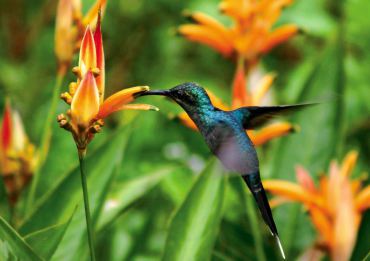 Butterflies need shelter from wind and places to rest. Create a wall or border around the butterfly garden area to minimize wind. The wall could be made of stone or brick. Or enclose two sides (or all sides) of the butterfly garden with a fence or trellis. Plant hops vine along the fence to provide a place for egg laying and caterpillar meals.
Butterflies need shelter from wind and places to rest. Create a wall or border around the butterfly garden area to minimize wind. The wall could be made of stone or brick. Or enclose two sides (or all sides) of the butterfly garden with a fence or trellis. Plant hops vine along the fence to provide a place for egg laying and caterpillar meals.
Male butterflies congregate in shallow puddles and muddy areas. Create a puddle or very shallow pool (only a few inches deep) to form a sandy area kept constantly damp. The butterfly puddling area can be as simple as a large saucer that holds water.
Try incorporating this short list of plants (listed by their most common names) to attract butterflies to your gardens. Many of these plants will also attract hummingbirds:
- Alyssum, annual, full sun to light shade (Note: Starts easily from seed and reseeds well; wonderful scent; attracts pollinators; comes in purple, peach and white.)
- Artemisia, Centaurea cineraria or Lychnis, grows in sun and shade (Note: These plants provide food for numerous species of butterfly larvae.)
- Asters (both annual and perennial varieties), full sun. (Note: This flower group is wide-ranging and includes daisies and sunflowers.)
- Bee balm (also called Oswego tea, horsemint, bergamot, monarda), perennial, full sun (Note: Keep soil fairly moist for best success with bee balm.)
- Calendula (pot marigold), annual, reseeds freely, full sun
- Caryopteris “Bluebeard,” deciduous shrub with gray green leaves, smells like lavender when leaves are crushed, full sun
- Catmint, Nepeta, perennial, full sun or partial shade
- Ceonothus (any variety will work), shrubs, full sun
- Blueberry (any variety will work), shrubs, full sun
- Chives, perennial, grows well from seeds or starts, full sun to partial shade (Note: Try growing garlic chives or plant other allium bulbs. Alliums range from the very tiny to the gigantic.)
- Coreopsis, perennials and annuals, bright yellow flowers (also pink, blue and white varieties), full sun
- Day lily, Hermerocallis, perennial from tuberous roots, full sun but will tolerate partial shade
- Dill, Anethum graveolens, annual, full sun
- Dusty Miller, Cineraria maritima, or any other plant with silver/gray leaves
- Echinacea purpurea, perennial, full sun (Note: Other varieties of echinacea come in red, orange, pink, white and yellow)
- Eupatorium purpureum (Joe Pye Weed), perennial, full sun
- Gaillardia (also called blanket flower and painted daisy), perennial, full sun
- Heliotrope, perennial or annual depending on the variety, flowers often smell like vanilla, needs regular water
- Hollyhock, biennial or short-lived perennial, full sun, grows well from seed, sometimes prone to mildew
- Lavatera (tree mallow), perennial; or Lavatera trimestris, annual; both require full sun
- Lavender, Lavendula, evergreen, herbaceous shrub, full sun
- Marguerite Daisy, perennial, full sun
- Nasturtium, annual from seed, self-seeds, returns year after year in many West Sound gardens, best in sun
- Parsley, perennial sewn from seed or starts, full sun
- Rosemary, Rosemarinus officinalis, evergreen, herbaceous shrub, full sun
- Rudbeckia, perennial or biennial depending on the variety
- Sedum (stonecrop), perennial, full sun (Note: Autumn Joy has wonderful platform flowers for butterflies.)
- Scabiosa (pincushion flower), perennial or annual depending on the variety, full sun, many colors and shades, sometimes called butterfly flower
- Zinnia, annual, full sun, grows well from seed
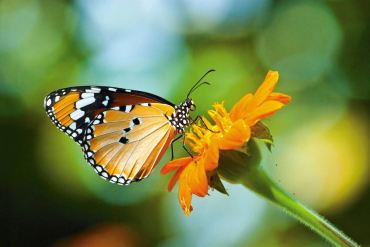 This list of plants is provided as a starting point to combine in creating a butterfly garden, or just mix in a few of these plants in an existing garden. Many of the plants provide a landing platform for butterflies. Others create the color palette to attract them. Still others provide a place to lay eggs and for caterpillars to feed.
This list of plants is provided as a starting point to combine in creating a butterfly garden, or just mix in a few of these plants in an existing garden. Many of the plants provide a landing platform for butterflies. Others create the color palette to attract them. Still others provide a place to lay eggs and for caterpillars to feed.
Trees, shrubs and vines are also an important feature in gardening for butterflies. These larger plants provide shelter from weather and predators. Several of the local butterflies even tuck themselves into the grooves in the bark of trees. Plants provide excellent camouflage for butterflies.
For even more information, send a self-addressed envelope to WSU Extension Office, 345 6th Street, Suite 550, Bremerton WA 98337-1874 to receive a planting plan, list of plants and butterflies for West Sound gardens. Write “butterfly” on the bottom of the envelope.






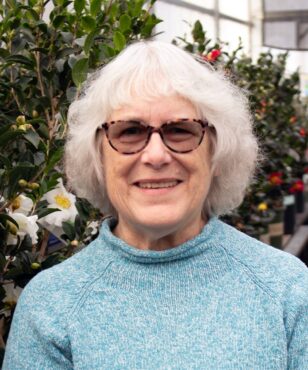

























Comments